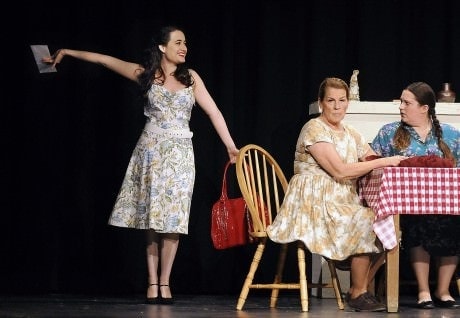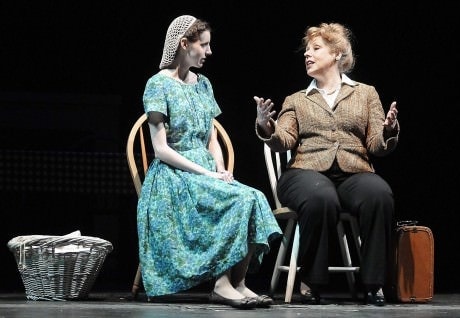The year is 1943 and Rosie the Riveter is home alone trying to figure out what to do with her life while her man is off to war. The Cover of Life, written by R.T. Robinson, and directed by Bob Sams, is an intriguing pre-feminism look at the search for intelligent life at a time when, for a woman, there appeared to be few signs. Given women’s imperfect yet significant social strides since World War II, the thematic for this play made you wonder if it would hold your attention for two hours. Closer examination, however, uncovered food for thought as the Bowie Community Theater set the stage for an enjoyable evening of thought-provoking social commentary.

Three young brides (Tood, Weetsie, and Sybil), married to brothers, go to live with the Cliffert boys’ mother (Aunt Ola) while the guys are away fighting the war in foreign lands. The slow, simple life of rural Sterling, Louisiana is the setting that reveals cracks in the surface of what appears to be an idyllic life of family and fortitude. Tipped off by a local stringer (Addie Mae), Life Magazine gets wind of the three women and the family’s hopeful coping during tough times of wartime separation. Life envoys a high-powered New York City female journalist (Kate Miller) down south to cover the lovely little “woman’s piece” and to put it on the cover of Life Magazine. Therein lies the rub.
The Cover of Life is a titular pun on many of the deeper dichotomies of life using the platform of a woman’s search for self-worth to shine the light in search of answers.
Diane Sams (Kate Miller), the narrator, delivers a solidly Devil Wears Prada-type characterization of the New York outsider being sent to the boonies. She’s a tough cookie in a man’s world with little sympathy for the homely lifestyle of these southern belles. The sophisticated versus the mundane; city girl vs. country girl cry out in comparison as Kate proudly proclaims, “If I ever said ‘I do, ’I’d disappear.” Kate moves from disdain to compassion, however, after she reluctantly “gets the scoop on the wives.” Living in the Cliffert home for a week, Kate uncovers the women’s covert desperation and truths hid by family falsehoods.
In a series of poignant monologues delivered on a bare center stage, standing in a glaringly revealing spotlight, the women lay bare their innermost yearnings as they struggle to find their worth and their way in a man’s world:
Tood is the young, determined, pregnant 19 year-old who more than the other two women defiantly questions her value and the freedom to have a say in her own life. “What’s wrong with my kind of dreamin?,” she asks. Liberated versus shackled; independent as opposed to dependent posit questions begging for a response. Caity Brown gives a knockout standout performance as Tood.
The sexy, flashy, cussin’ and drinkin’ Sybil, dynamically portrayed by Terra Vigil, can’t have children but deceives herself into thinking that her man still wants her because she’s “hot as a Saturday night and safe as Sunday morning.” Sybill comes out of denial when she gets a letter from her man from the front lines and then tragically reckons with being considered incomplete as a woman.
Weetsie longs to live the barefoot and pregnant life hoping that her man will return soon so they can start a family. The plain, plump country girl colorfully played by Rinn Delaney is sure that “Southern boys want to marry their mammas.” But underneath her happy “chubby and warm as a chenille bathrobe” exterior is an interior that is grubbing for money as she connives to close the gap from poorer to richer by taking family funds.
The strong southern matriarch, Aunt Ola, is mother-in-law to the young women and the long-suffering but pistol-toting, feisty wife to an old codger whom she can’t wait to die. Kathryn Huston gives a fine performance as the center of gravity of the Cliffert home who is searching for her own real power in a world of female powerlessness where men are given free rein to cheat, drink, abuse and cut the fool.
Addie Mae (Whisper Washington) is the local newspaper reporter trying to be upwardly mobile and stylishly correct in a patriarchal society where writing a woman’s feature story is a big deal for a female journalist. Her superficiality belies the way she feels about herself and her work.
The powerful Henry Luce, Life Magazine editor, unseen but behind the scene, is making arrangements so the three husbands can come home to take the cover shot for Life. Tommy (Ian M. Cooper), the weak-willed sailor affectionately called “Teet” by family, is husband to Tood and the only one that we see come home from war in the South Pacific. “Something happened to you while I was gone” is his reaction to a frustrated but visionary Tood. The security of Tommy’s future dreams to build a home next door to Mama give way to insecurity and uncertainty as his marriage to Tood teeters on the verge.

Lighting by Garrett Hyde played an important part in developing the characterization. Cold spots on bare-stage monologues and the confusion between daylight and night darkness cast a shadow on the contradictions and hidden truths underlying the lives of the characters. There were frequent blackouts, however, changing the set. But when the lights came back up, nothing much had moved. Lighting was used to set the scenes and to sequence the pace of the performance but it only seemed to slow down the action, instead. The blackouts, too numerous to count, became a distraction that affected the momentum of the performance. The simple set by Gerard Wiliams and Bob Sams around the kitchen table was starkly effective in its lack of pretense. Music from the 40s played between acts but to little effect. There could have been more music to add color and mood. The Cover of Life uncovered more questions than it provided answers.
Running Time: Two hours, with a 15 minute intermission.
The Cover of Life plays through November 24, 2013 at Bowie Community Theatre performing at the Bowie Playhouse – 16500 White Marsh Park Drive, in White Marsh Park, Rt. 3 South,in Bowie, MD. For tickets call the box office at (301) 805-0219, or purchase them online.





